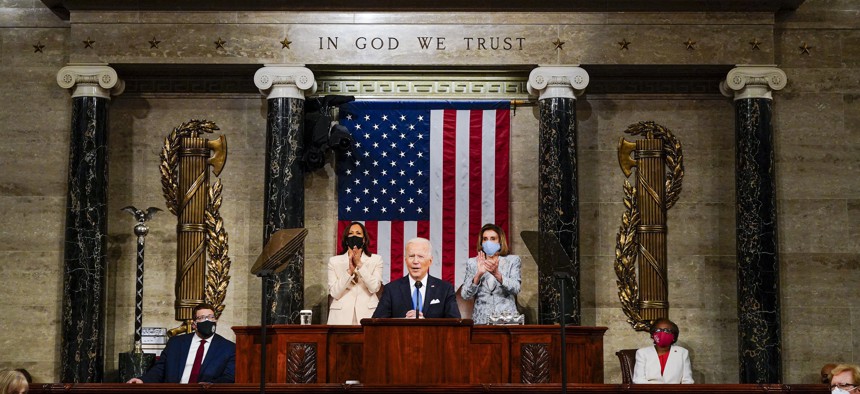Treasury to Begin Distribution of $350 Billion for State, Local Governments

Vice President Kamala Harris and House Speaker Nancy Pelosi of Calif., stand and applaud as President Joe Biden addresses a joint session of Congress, Wednesday, April 28, 2021, in the House Chamber at the U.S. Capitol in Washington. Melina Mara/The Washington Post via AP, Pool
The guidance released Monday gives governments wide latitude in spending American Rescue Plan funds.
The Treasury Department will begin to distribute $350 billion in federal aid to state and local governments in the coming days, officials announced Monday as they issued long-awaited guidance on how the funds can be spent.
From covering payroll and benefits for public health workers primarily deployed to respond to the coronavirus pandemic to replenishing unemployment insurance trust funds, the guidance provides state and local governments specifics on a broad range of spending options eligible under the American Rescue Plan.
The guidance also outlines when governments can expect to receive tranches of money and provides more specificity on ineligible expenditures, such as use of the funds to replenish rainy day funds or to offset a reduction in taxes.
State and local governments may use the funding to address need in six broad areas:
- Support a range of public health needs, including coronavirus mitigation efforts.
- Alleviate economic hardship the pandemic caused for businesses, workers and affected industries.
- Provide aid for hard-hit communities.
- Replace lost government tax or fee revenues.
- Provide hazard pay for essential workers.
- Invest in water, sewer and broadband infrastructure.
The Biden administration plan allocates $350 billion in federal stimulus money to state, local and tribal governments as a way to help communities recover from the economic effects of the coronavirus pandemic. Under the plan, states and the District of Columbia will receive $195 billion, counties will receive $65 billion, cities will receive $46 billion, and tribal governments will receive $20 billion.
“With this funding, communities hit hard by Covid-19 will be able to return to a semblance of normalcy; they’ll be able to rehire teachers, firefighters and other essential workers, and to help small businesses reopen safely,” said Treasury Secretary Janet Yellen.
The funding can be used to cover a broad range of government operations expenses, including payroll and benefits for public health and public safety employees whose units or divisions are primarily dedicated to coronavirus response efforts. It can also be used to provide “premium pay” to nongovernment essential workers (either directly or through grants to private employers) such as child care or sanitation workers or staff at nursing homes.
Since the American Rescue Plan was signed into law in March, state and local government leaders have anxiously awaited additional guidance on how the money can be spent. State leaders have specifically raised concern about a last-minute addition included in the legislation that prevents states from using the money to pay for tax cuts—and some states have sued claiming the tax mandate is unconstitutional.
The guidance issued Monday provides more clarity on that issue.
An interim rule that further outlines ineligible spending states that the Treasury Department will use inflation-adjusted fiscal 2019 tax revenue as a baseline for determining whether a state has a net tax reduction. If the state’s tax revenue is greater than that amount, the government will not be considered to have violated the offset provision.
The Treasury Department’s interpretation means that states could still cut taxes so long as revenue growth is strong, wrote Jared Walczak, the vice president of state projects at the Tax Foundation.
But if the state’s tax revenue is lower than the 2019 total, the Treasury Department will require the state to identify sources of funds that have been used to offset the total value of tax changes, such as an increase in a tax rate, or spending cuts.
If states do cut taxes, the guidance says “they must demonstrate how they paid for the tax cuts from sources other than Coronavirus State Fiscal Recovery Funds—by enacting policies to raise other sources of revenue, by cutting spending, or through higher revenue due to economic growth.” If the federal funding is used to offset tax cuts, states will be required to pay back the offset amount to the Treasury Department.
Reductions in spending cannot be in any department or agency where a state has spent the recovery funds, a particularly broad interpretation that could be problematic for states, Walczak wrote.
“Functionally, accepting federal funds could mean that tax cuts could not be financed by any savings—no matter how far removed from the federal aid—in departments dealing with public health, public safety, education, social services, and certain infrastructure projects,” he said. “This represents a massive federal entanglement in state fiscal authority.”
The Treasury Department indicated that eligible governments could begin to receive funding in the coming days, and the guidance provides more specificity the breakdown of payments.
States that saw unemployment rates increase by more than 2% since February 2020 will be eligible to receive the full amount of federal coronavirus funding in one lump sum. Other states will receive payments in two equal tranches. States are required to sign certification documents attesting they will spend the money only in certain ways prescribed by the law. The Treasury Department is required to release an initial aid payment within 60 days of a state’s certification.
Local governments will receive funding in two equal tranches, with the first payments beginning this month and the second half delivered a year later.
The executive director of the National Association of Counties, Matthew Chase, said the flexibility in funding will allow local governments to use the money for a wide variety of important projects such as investment in broadband infrastructure and public health measures.
“This aid represents an historic investment in counties on the front lines of our nation’s coronavirus response and recovery efforts,” he said.
Andrea Noble is a staff correspondent with Route Fifty.
NEXT STORY: GOP Governors Move to End Pandemic Unemployment Benefits





